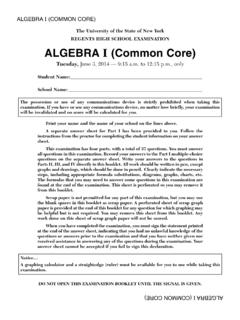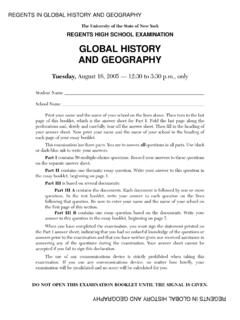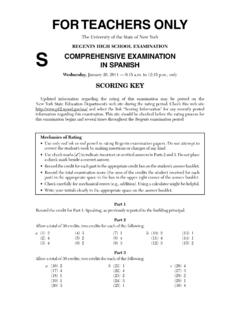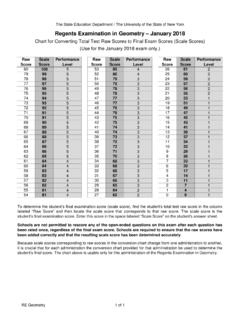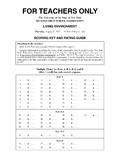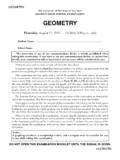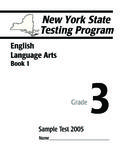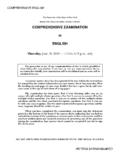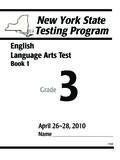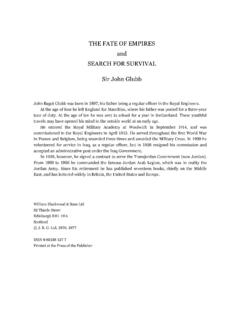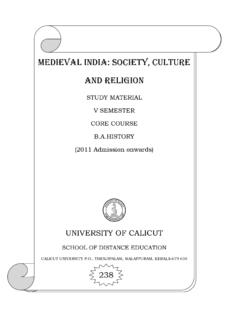Transcription of GLOBAL HISTORY AND GEOGRAPHY - Regents …
1 The University of the State of New York Regents HIGH SCHOOL EXAMINATION. GLOBAL HISTORY . AND GEOGRAPHY . Wednesday, June 18, 2003 1:15 to 4:15 , only Student Name _____. School Name _____. Print your name and the name of your school on the lines above. Then turn to the last page of this booklet, which is the answer sheet for Part I. Fold the last page along the perforations and, slowly and carefully, tear off the answer sheet. Then fill in the heading of your answer sheet. Now print your name and the name of your school in the heading of each page of your essay booklet. This examination has three parts. You are to answer all questions in all parts. Use black or dark-blue ink to write your answers. Part I contains 50 multiple-choice questions. Record your answers to these questions on the separate answer sheet. Part II contains one thematic essay question. Write your answer to this question in the essay booklet, beginning on page 1. Part III is based on several documents: Part III A contains the documents.
2 Each document is followed by one or more question(s). In the test booklet, write your answer to each question on the lines following that question. Be sure to enter your name and the name of your school on the first page of this section. Part III B contains one essay question based on the documents. Write your answer to this question in the essay booklet, beginning on page 7. When you have completed the examination, you must sign the statement printed on the Part I answer sheet, indicating that you had no unlawful knowledge of the questions or answers prior to the examination and that you have neither given nor received assistance in answering any of the questions during the examination. Your answer sheet cannot be accepted if you fail to sign this declaration. DO NOT OPEN THIS EXAMINATION BOOKLET UNTIL THE SIGNAL IS GIVEN. Part I. Answer all questions in this part. Directions (1 50): For each statement or question, write on the separate answer sheet the number of the word or expression that, of those given, best completes the statement or answers the question.
3 Base your answer to question 1 on the diagram below and on your knowledge of social studies. Central Organized Governments Religion Different Social Jobs Classes System of Art and Writing Architecture Roads, Bridges, Temples, and other Cities Public Works Source: Guide to the Essentials of World HISTORY , Prentice Hall 1 Which title best completes this diagram? (1) Elements of a Civilization (2) Features of a Nomadic Lifestyle (3) Basic Components of the Paleolithic Age (4) Human Life 50,000 Years Ago 2 Which feature would most often be shown on a 5 One reason the Euphrates, Indus, Nile, and political map? Tigris valleys became centers of early civilization (1) topography (3) capital cities is that these valleys had (2) type of climate (4) elevation (1) borders and elevations that were easy to defend 3 The geographic isolation of a society most often (2) rich deposits of coal and iron ores leads to the (3) the means for irrigation and transportation (1) development of trade (4) locations in regions of moderate climate and (2) strengthening of traditional culture abundant rainfall (3) promotion of cultural diffusion (4) growth of international alliances 6 Hammurabi's Code, the Ten Commandments, and the Twelve Tables were all significant to their 4 In a traditional economic system, which type of societies because they established goods is most often produced?
4 (1) democratic governments (1) agricultural products (2) official religions (2) heavy industrial machinery (3) rules of behavior (3) military supplies (4) economic systems (4) electronics and computers GLOBAL Hist. & Geo. June '03 [2]. Base your answers to questions 7 and 8 on the map below and on your knowledge of social studies. 7 The information provided by the map indicates that in 1280 the Mongols controlled (1) areas of Africa, Asia, and Europe (2) territory from eastern China to eastern Europe (3) Japan and Korea (4) all of Asia 8 What was the effect of the extensive Mongol Empire on the people who lived in Europe and Asia in the 1200s? (1) development of a common language (2) adoption of Confucian ideas and practices (3) expansion of Japanese cultural traditions (4) significant increases in trade and travel 9 Which quotation from the teachings of Confucius 10 The West African kingdoms of Ghana, Mali, and is most similar to the Golden Rule from Judeo- Songhai experienced economic prosperity because Christian teaching?
5 They all (1) If a ruler is upright, all will go well without (1) controlled vast reserves of oil and gold orders. (2) traded with many other nations (2) By nature, men are pretty much alike. It is (3) maintained highly structured feudal systems learning and practice that set them apart. (4) solved tribal conflicts within their empires (3) While a father or mother is alive, a son should not travel far.. (4) Do not do to others what you do not wish for yourself.. GLOBAL Hist. & Geo. June '03 [3] [OVER]. Base your answers to questions 11 and 12 on the 14 Ibn Battuta and Marco Polo were similar in that illustration below and on your knowledge of social both studies. (1) ruled over vast empires that included diverse peoples (2) produced written records of their extensive travels (3) converted thousands of people to Christianity (4) fought to free their people from Mongol rule 15 Tedious were it to recount, how citizen avoided citizen, how among neighbours was scarce found any that shewed fellow-feeling for another, how kinsfolk held aloof, and never met, or but rarely.
6 Enough that this sore affliction entered so deep into the minds of men and women, that in the horror thereof brother was forsaken by brother, nephew by uncle, brother by sister, and 11 The illustration represents a society based on oftentimes husband by wife; nay, what is more, (1) social class and scarcely to be believed, fathers and mothers (2) educational achievement were found to abandon their own children, (3) accumulated wealth untended, unvisited, to their fate, as if they had (4) political ability been strangers.. Giovanni Boccaccio, The Decameron 12 This illustration suggests that the European The author of this passage was describing the feudal system was (1) breakdown of social order during the bubonic (1) designed to promote political and economic plague equality (2) power of special courts during the Inquisition (2) controlled by a powerful middle class (3) treatment of native peoples in Latin American (3) intended to provide opportunities for social nations mobility (4) outcome of the famine in Ireland in the 1890s (4) supported by the labor of the peasants 16 The GLOBAL transfer of foods, plants, and animals during the colonization of the Americas is known 13 The countries beyond the horizon and from the as the ends of the Earth have all become subjects and (1) Scientific Revolution (3) New Imperialism to the most western of the western or the most (2) Columbian Exchange (4) Middle Passage northern of the northern countries however far away they may be.
7 17 One way Martin Luther, John Calvin, and Henry Ming dynasty official VIII were similar is that they all were The intent of this statement about the Ming (1) Latin American revolutionary leaders dynasty was to (2) Reformation leaders (1) demonstrate supremacy and strength in China (3) Impressionist painters (2) control the Mongols (4) divine right monarchs (3) stop European imperialism (4) impose Chinese culture and slavery on neigh- boring countries GLOBAL Hist. & Geo. June '03 [4]. Base your answers to questions 18 and 19 on the map below and on your knowledge of social studies. 18 Which statement can best be supported by the information on the map? (1) The Portuguese taught the Chinese their sailing knowledge. (2) Portugal and China practiced isolationism throughout the 15th century. (3) Only the Portuguese explored the east coast of Africa. (4) The Portuguese and the Chinese were active explorers. 19 Which two explorers are associated with the travels shown on the map? (1) Ferdinand Magellen and Matthew Perry (2) Christopher Columbus and Genghis Khan (3) Vasco de Gama and Zheng He (4) Francisco Pizarro and Marco Polo GLOBAL Hist.
8 & Geo. June '03 [5] [OVER]. Base your answer to question 20 on the map below 21 Which economic theory, developed in the 17th and on your knowledge of social studies. century, supported European colonialism? (1) socialism (3) bartering (2) mercantilism (4) feudalism Base your answer to question 22 on the statements below and on your knowledge of social studies. Speaker A: The state of monarchy is supreme on earth: for kings are not only God's lieutenants upon earth and sit upon God's throne, but even by God himself they are called gods.. Speaker B: If government fails to fulfill the end for which it was established the preservation of the individual's right to life, liberty, and property the people have a right to dissolve the government.. Speaker C: But what if the compact between the ruler and ruled is violated by the ruler? He thus becomes a tyrant, a criminal who forfeits his rights to the obedience of his subjects, who may now exercise their right to rebel and form a new compact.
9 Speaker D: The ruling authority in the state, the sovereign, must have supreme power, or society will collapse and the anarchy of the state of nature will return.. 20 Which conclusion regarding early European settlements is best supported by the information 22 Which two speakers would support absolutism? on the map? (1) A and D (3) C and D. (1) Portugal became the dominant colonial (2) B and C (4) A and B. power in South America by 1600. (2) GEOGRAPHY made the interior of South America easy to explore. 23 Which list of French leaders is in the correct (3) Neither the Spanish nor the Portuguese chronological order? developed major urban centers in Latin America. (1) Louis XVI Napoleon Robespierre (4) In 1600, most of the land in South America (2) Robespierre Napoleon Louis XVI. was not settled by Europeans. (3) Louis XVI Robespierre Napoleon (4) Napoleon Louis XVI Robespierre GLOBAL Hist. & Geo. June '03 [6]. Base your answers to questions 24 and 25 on the 26 When the legislative and executive powers are quotations below and on your knowledge of social united in the same person, or in the same body of studies.
10 Magistrates [government officials], there can be no liberty; because apprehensions [fears] may Quotation 1: arise, lest the same monarch or senate should The Humble ADDRESS and PETITION of enact tyrannical laws to execute them in a Thousands, who labor in the Cloth Manufactory. tyrannical manner.. Baron de Montesquieu, Spirit of the Laws SHEWETH, That the Scribbling-Machines have thrown thousands of your petitioners out Which solution would Baron de Montesquieu of employ, whereby they are brought into great offer to avoid the enactment of tyrannical laws? distress, and are not able to procure a (1) granting freedom of speech maintenance for their families, and deprived (2) reinstating absolute monarchies them of the opportunity of bringing up their (3) separating the branches of government children to labour: We have therefore to (4) limiting natural laws request, that prejudice and self-interest may be laid aside, and that you may pay that attention to the following facts, which the nature of the 27 Which factors helped cause the defeat of case requires.
